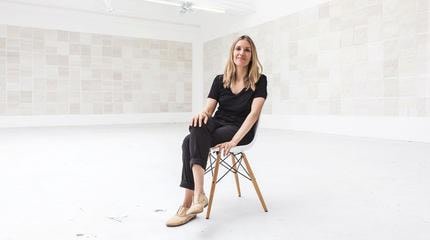
In 1996, Liza Lou unveiled “Kitchen” — a lifesize suburban kitchen rendered entirely in beads. The piece, which included a box of glittering Frosted Flakes and a cherry pie that gleamed like the crown jewels, took the artist five years to make. Soon followed “Backyard,” a vast suburban lawn, beaded down to the blades of grass. Since then, Lou’s work has continued to involve beads, though it has evolved considerably in both method and subject matter. (She rendered a security fence entirely in beads in 2005, a life-size replica of a San Quentin jail cell from 2004 to 2006 and 365 woven pages stacked atop each other for “The Book of Days” in 2010.)
“The Waves,” her new show opening at the Galerie Thaddaeus Ropac in Salzburg this weekend, is again a departure from that earlier work. In contrast to the elaborately intricate and brightly shimmering surfaces and recognizable brands in “The Kitchen,” this piece is positively quiet. And at first glance, it is simple: 1,000 white dishcloths hang side by side from floor to ceiling. But the work speaks volumes — and represents a shift in the way Lou has come to think about her work.
In 2005, she began splitting her time between her home in Los Angeles and Durban, South Africa, where she began employing Zulu women from an area with a long history of beadwork: the coastal province of KwaZulu-Natal. The ethos of her workshop was to provide safe working conditions (often allowing women to work from home, so they can also look after their children) and generous salaries. She calls it a “unilateral studio, where we all sit at the table elbow to elbow.” Lou says that in many ways, the Durban studio has taught her about being an artist. Once she got to know the community and the women she worked along side, she says, “I learned so much from just being with them, sitting with them, sharing stories — and saw that I could make a real difference if I could listen more and say less.” She continues: “Slowly over the years, I started to see that my job as an artist is to listen deeply and really watch.”
Her work in Durban has had a great effect on her practice, too. “In my early days as an artist, I thought that process didn’t matter,” Lou says. “I made a kitchen, it took me five years, and I thought: ‘Yeah, I suffered, yeah it was difficult, but the point is ‘The Kitchen’ should just be its own thing — it shouldn’t matter that it took me five years, it should stand on its own.” Working in Africa, she says, taught her how important the process of making something is to the final work. “The story and the way things are made is very important, it is part of the meaning,” she says. “I don’t think you can separate the meaning from how things are made. And if we do that, then what we do is negate labor, and the people that are part of a process.” She continues: “ I think my work is very much the story of how things are made.”
To create “The Waves,” Lou handed out packets of 300 grams of white beads to each of her artisans — many of whom now oversee their own teams of workers. Her only stipulation to each team: to produce panels of equal dimensions. Each piece, she said, came back “as an incredible painting,” and looked totally unique. Each had unintentional stains — dirt smudges, mud and evidence of the hand of each worker, many of whom live in rural areas. Not a single piece was returned perfectly white.
When viewed as a whole, “The Waves” conveys a powerful message about the importance of unseen labor. Another piece in the show, titled simply “Blue,” comprises monochrome canvases shimmering with blue beads that Lou says is a reference to the importance of the ocean in Durban. But it, too, has streaks born from the artisans who made it. “I’m interested in the perfection that really involves error. When you can see the hand — when you can see that something went wrong, I think there’s so much beauty in that.” Lou says. She pauses to reference a line from the Leonard Cohen song “Anthem:” “There’s a crack in everything — that’s how the light gets in.”
Photo by Byron du Bois
